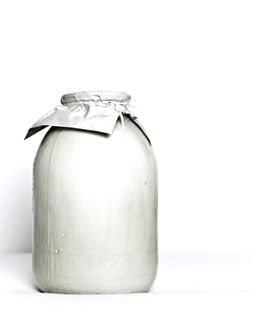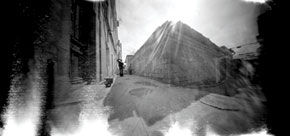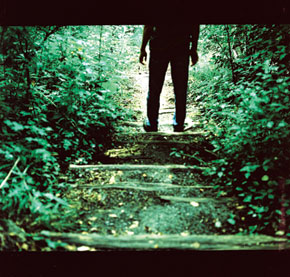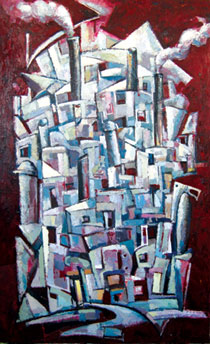Pages 90-94
by Ian Peart
Azerbaijan is a country that celebrates its diversity in many ways – geographically located at a historical crossroads of trade routes and having until relatively recently a population with nomadic traditions, it has inevitably been influenced by the many who have crossed its territory.
It is often the case that these new ideas are more readily taken up by younger, more idealistic generations and their advent has often caused dispute but, over time, the new and the traditional have usually combined to produce a new form. This phenomenon was recognised at least two and a half millennia ago…
"All things come into being by conflict of opposites." ~ Heraclitus, Ephesus, 6th century BC
The tradition was continued in Baku by an art exhibition organized on 7th September. Hundreds streamed into the unlikely venue of the venerable Veten Cinema to view the produce of young artists at their ‘Art Bazaar’. This art was deliberately not in a gallery and its visitors were overwhelmingly from the rising generation
The Bazaar
To be honest, exhibition openings are not among this reviewer’s favourite events. They are usually crowded with people who assemble to chat, positioning themselves just so as to make it impossible for anyone else to see the exhibits they are ignoring. In an apparent attempt to overcome this problem, Art Bazaar turned off the lights.... and issued torches – 300 of them – to encourage visitors to be more active in selecting their viewing. Conditions were difficult; Veten is showing its age, the air-conditioning was not up to the struggle and this veteran staggered out after 20 minutes, sweating buckets. However, this was not before noticing that younger visitors, more sensibly dressed for a disco atmosphere (did I mention DJ Monkey Mind’s musical ‘installation’?) were in their funky element. Not before noticing also, that there were exhibits well worth a serious look and that many of the youth were actually pointing their torches in the direction hoped for by the organisers. They were aimed at photographs (digital, pinhole and 3-D), paintings, graphics and videos.
The Product
An interview later with project curator Sitara Ibrahimova elicited the complaint that many reviewers had concentrated on the conditions and ignored the art; so what about the products in store at this bazaar? By the time I returned, on 14 September, the last day of the exhibition, the cinema was almost back to usual day-time mode and the exhibits had been pushed aside to make room for the table tennis players; the videos had disappeared. The remains included Samir Salakhov’s series of 6 portraits – essentially black and white in watercolour, with something of the cartoon about them and technically impressive. They are all looking obliquely outward, as if not fully trusting the viewer. Except one, which is an angry, or pained, Hulk-ish ‘Self-portrait’. Mr Salakhov clearly has strong views on life – will they be revealed further in future works?
‘Bazaar’ conjures an image of a place teeming with ordinary people buying ordinary, sometimes extraordinary, things and many of the artists here had extracted from daily life to endow the ordinary with extra significance – perhaps in the way of Marcel Duchamps’ found objects. Some of Habib Muradov’s pinhole digital prints give a dreamlike quality to ‘ordinary’ landscapes that invite you to wonder about the stories that could happen there. The still in the exhibition programme from Majid Aliyev’s video ‘On my way’ deepened my regret that I’d missed the original; there is something dynamic about the attitudes of the people on a (late night?) bus that compels you to observe and appreciate their individuality. Javidan Akhundov’s digital print ‘Now-forever’ captures fragments of moments and holds them in suspense, leaving the viewer again ponder in a different way over identities, outcomes and surroundings.
Aysel Amirova and Arif Amirov convey dense city landscapes in their paintings, with varying degrees of abstraction. While Arif focuses more on its mechanical functioning, Amirova seems to be more taken with the individual’s search for identity, especially in ‘Road’, as a figure stands before a street zigzagging through a maze of houses. Her ‘Labyrinth’ has a black and white, cubist street scene – an urban idyll of a simpler past? - framed at the centre of a brightly coloured abstract, suggestive of a more congested and less individualistic modern city. She had also, apparently, contributed poems; I saw the yellow papers lying around on my first visit but, like other elements, they got lost in the mêlée...
Lala Lutfalibekova, Sitara Ibrahimova and Tahmina Akhmedova all play with beauty and its fantasies in their digital prints. Sadly, by my second visit there were none of the 3D glasses needed to fully appreciate Ibrahimova’s ‘Dream of the trucker’ – her take on the type of ‘pin-up’ calendar you used to see in western garage repair shops. Supposedly depicting the first five months of an ancient Roman calendar, it combines classical and modern nude poses..... The classical marble carving of the ‘Venus de Milo’ in the Louvre is true art, whereas a photograph of a real woman in similar pose on a mechanic’s calendar is.....? The concept of women’s beauty is considered by Lutfalibekova, with a model depicted behind plastic sheeting and adorned by various accessories to enhance her cosmetic looks in her five prints, ‘Artificial beauty’. Akhmedova splashes colour into her ‘Beauty series’ of black and white prints, suggesting the sacrifices (torture?) undergone to achieve the fantasy.
Behind the counter
That second visit brought some rewarding contacts with fine, intriguing art and Sitara Ibrahimova was quite clear about its motivation:
“There are so many talented people,” she said, “why shouldn’t they be seen?”
Having recently completed three year’s study of photography in Prague, she is keen to promote the art and overcome the frustration faced by all young artists when trying to break through the grip established figures have on the imagination of the media. Thus, she responded to an initiative by Asiyat Fatullayeva, chair of the Photographers’ Union, and agreed to take on the new experience of curating an exhibition – she also had support from the city’s Kichik Galart centre.
Conscious that many young people don’t cross the hallowed portals of formal galleries and are more likely to experience art second-hand via Facebook, the group assembled to organise a first-hand encounter had originally wanted an outdoor venue, but practical problems proved to be insurmountable at that stage. In the end the slightly down-at-heel Veten Cinema was felt to be just the place for the bazaar concept.
Curator Ibrahimova was pleased, both:
that the artists had had the encouragement of a popular exhibition of their works,
“New photographers, especially, get few chances to exhibit”
and that so many (2,000 on the first day?) had turned up,
“Instead of watching a soap opera, they came to an exhibition. We wanted a different approach and for people to be engaged with, and exchange ideas about, art.”
I understand that later in September there was a meeting to review the event. There will certainly be some lessons learned, but one hopes that this tangy display of home-made talent, like its bazaar-style jar of yoghurt emblem, has whetted the appetite of youth for further exchanges at the Art Bazaar.
by Ian Peart
Azerbaijan is a country that celebrates its diversity in many ways – geographically located at a historical crossroads of trade routes and having until relatively recently a population with nomadic traditions, it has inevitably been influenced by the many who have crossed its territory.
It is often the case that these new ideas are more readily taken up by younger, more idealistic generations and their advent has often caused dispute but, over time, the new and the traditional have usually combined to produce a new form. This phenomenon was recognised at least two and a half millennia ago…
"All things come into being by conflict of opposites." ~ Heraclitus, Ephesus, 6th century BC
The tradition was continued in Baku by an art exhibition organized on 7th September. Hundreds streamed into the unlikely venue of the venerable Veten Cinema to view the produce of young artists at their ‘Art Bazaar’. This art was deliberately not in a gallery and its visitors were overwhelmingly from the rising generation
The Bazaar
To be honest, exhibition openings are not among this reviewer’s favourite events. They are usually crowded with people who assemble to chat, positioning themselves just so as to make it impossible for anyone else to see the exhibits they are ignoring. In an apparent attempt to overcome this problem, Art Bazaar turned off the lights.... and issued torches – 300 of them – to encourage visitors to be more active in selecting their viewing. Conditions were difficult; Veten is showing its age, the air-conditioning was not up to the struggle and this veteran staggered out after 20 minutes, sweating buckets. However, this was not before noticing that younger visitors, more sensibly dressed for a disco atmosphere (did I mention DJ Monkey Mind’s musical ‘installation’?) were in their funky element. Not before noticing also, that there were exhibits well worth a serious look and that many of the youth were actually pointing their torches in the direction hoped for by the organisers. They were aimed at photographs (digital, pinhole and 3-D), paintings, graphics and videos.
The Product
An interview later with project curator Sitara Ibrahimova elicited the complaint that many reviewers had concentrated on the conditions and ignored the art; so what about the products in store at this bazaar? By the time I returned, on 14 September, the last day of the exhibition, the cinema was almost back to usual day-time mode and the exhibits had been pushed aside to make room for the table tennis players; the videos had disappeared. The remains included Samir Salakhov’s series of 6 portraits – essentially black and white in watercolour, with something of the cartoon about them and technically impressive. They are all looking obliquely outward, as if not fully trusting the viewer. Except one, which is an angry, or pained, Hulk-ish ‘Self-portrait’. Mr Salakhov clearly has strong views on life – will they be revealed further in future works?
‘Bazaar’ conjures an image of a place teeming with ordinary people buying ordinary, sometimes extraordinary, things and many of the artists here had extracted from daily life to endow the ordinary with extra significance – perhaps in the way of Marcel Duchamps’ found objects. Some of Habib Muradov’s pinhole digital prints give a dreamlike quality to ‘ordinary’ landscapes that invite you to wonder about the stories that could happen there. The still in the exhibition programme from Majid Aliyev’s video ‘On my way’ deepened my regret that I’d missed the original; there is something dynamic about the attitudes of the people on a (late night?) bus that compels you to observe and appreciate their individuality. Javidan Akhundov’s digital print ‘Now-forever’ captures fragments of moments and holds them in suspense, leaving the viewer again ponder in a different way over identities, outcomes and surroundings.
Aysel Amirova and Arif Amirov convey dense city landscapes in their paintings, with varying degrees of abstraction. While Arif focuses more on its mechanical functioning, Amirova seems to be more taken with the individual’s search for identity, especially in ‘Road’, as a figure stands before a street zigzagging through a maze of houses. Her ‘Labyrinth’ has a black and white, cubist street scene – an urban idyll of a simpler past? - framed at the centre of a brightly coloured abstract, suggestive of a more congested and less individualistic modern city. She had also, apparently, contributed poems; I saw the yellow papers lying around on my first visit but, like other elements, they got lost in the mêlée...
Lala Lutfalibekova, Sitara Ibrahimova and Tahmina Akhmedova all play with beauty and its fantasies in their digital prints. Sadly, by my second visit there were none of the 3D glasses needed to fully appreciate Ibrahimova’s ‘Dream of the trucker’ – her take on the type of ‘pin-up’ calendar you used to see in western garage repair shops. Supposedly depicting the first five months of an ancient Roman calendar, it combines classical and modern nude poses..... The classical marble carving of the ‘Venus de Milo’ in the Louvre is true art, whereas a photograph of a real woman in similar pose on a mechanic’s calendar is.....? The concept of women’s beauty is considered by Lutfalibekova, with a model depicted behind plastic sheeting and adorned by various accessories to enhance her cosmetic looks in her five prints, ‘Artificial beauty’. Akhmedova splashes colour into her ‘Beauty series’ of black and white prints, suggesting the sacrifices (torture?) undergone to achieve the fantasy.
Behind the counter
That second visit brought some rewarding contacts with fine, intriguing art and Sitara Ibrahimova was quite clear about its motivation:
“There are so many talented people,” she said, “why shouldn’t they be seen?”
Having recently completed three year’s study of photography in Prague, she is keen to promote the art and overcome the frustration faced by all young artists when trying to break through the grip established figures have on the imagination of the media. Thus, she responded to an initiative by Asiyat Fatullayeva, chair of the Photographers’ Union, and agreed to take on the new experience of curating an exhibition – she also had support from the city’s Kichik Galart centre.
Conscious that many young people don’t cross the hallowed portals of formal galleries and are more likely to experience art second-hand via Facebook, the group assembled to organise a first-hand encounter had originally wanted an outdoor venue, but practical problems proved to be insurmountable at that stage. In the end the slightly down-at-heel Veten Cinema was felt to be just the place for the bazaar concept.
Curator Ibrahimova was pleased, both:
that the artists had had the encouragement of a popular exhibition of their works,
“New photographers, especially, get few chances to exhibit”
and that so many (2,000 on the first day?) had turned up,
“Instead of watching a soap opera, they came to an exhibition. We wanted a different approach and for people to be engaged with, and exchange ideas about, art.”
I understand that later in September there was a meeting to review the event. There will certainly be some lessons learned, but one hopes that this tangy display of home-made talent, like its bazaar-style jar of yoghurt emblem, has whetted the appetite of youth for further exchanges at the Art Bazaar.






